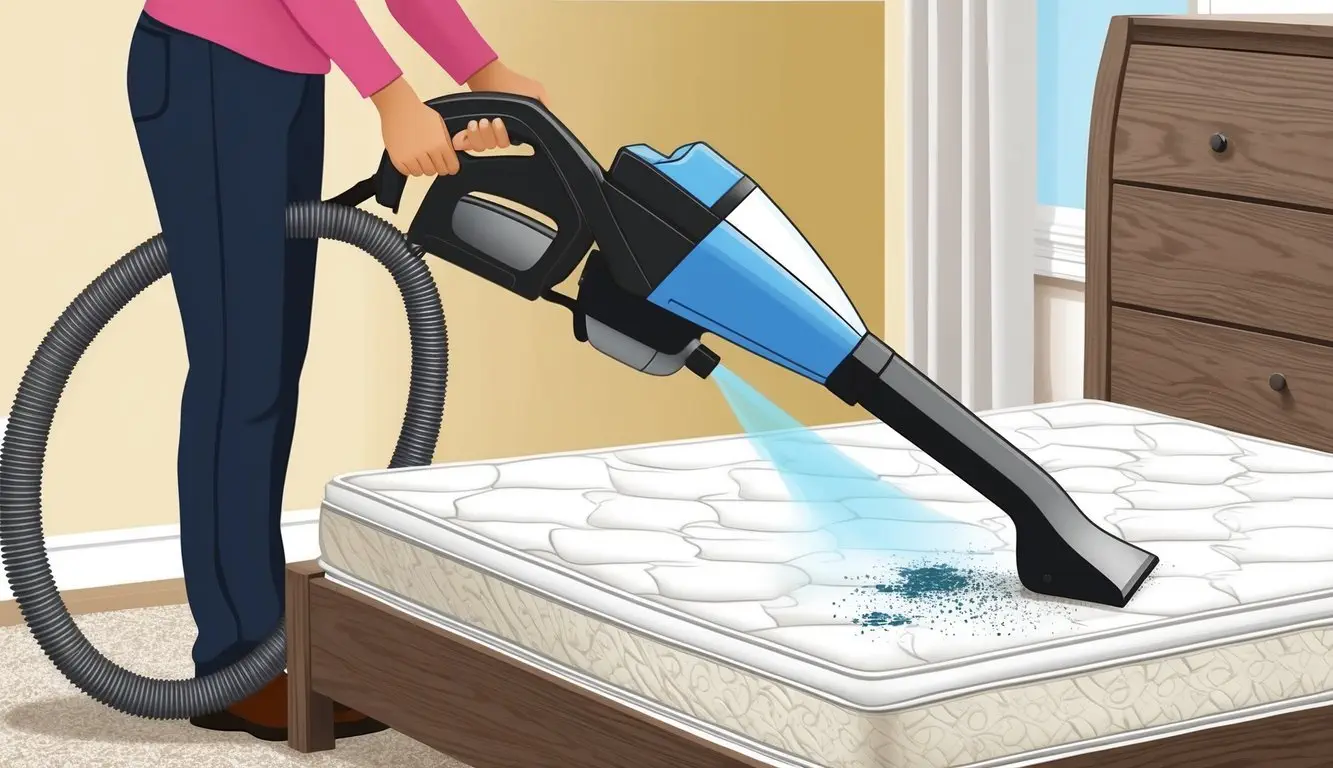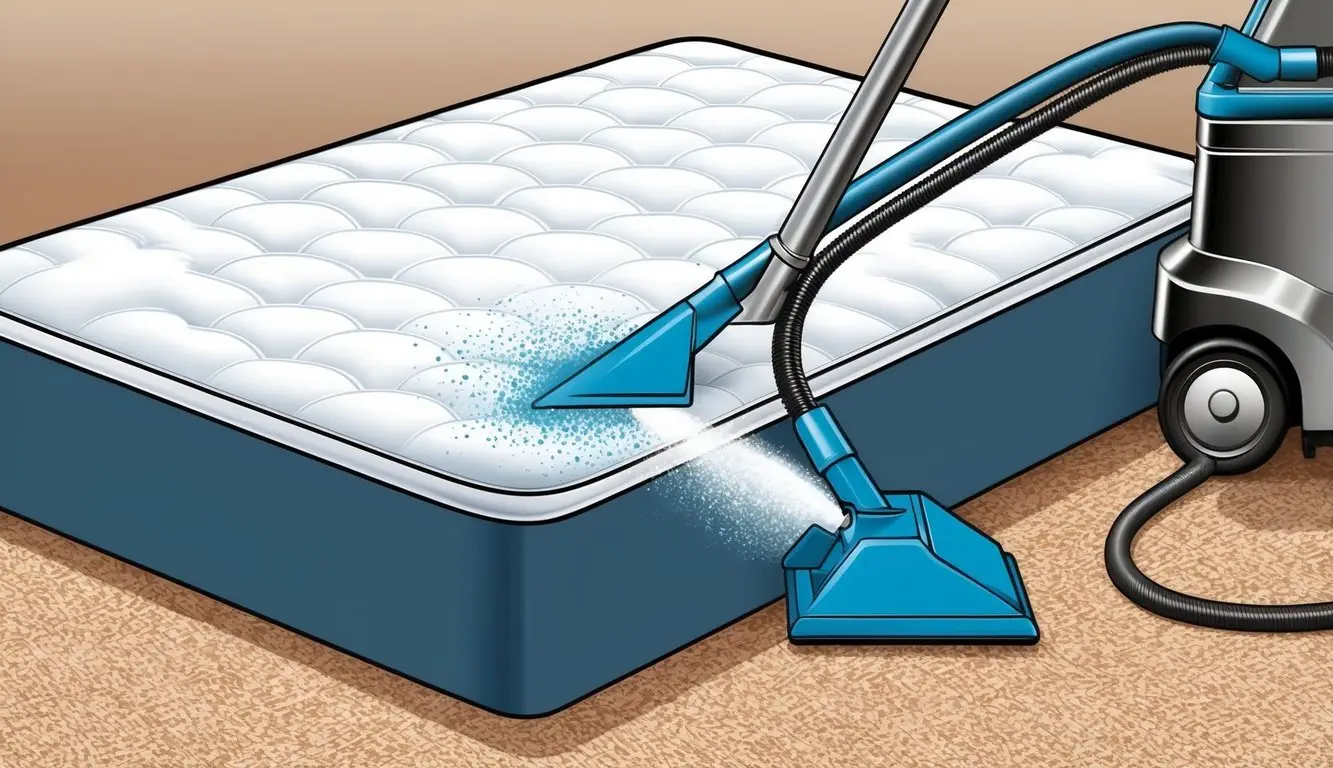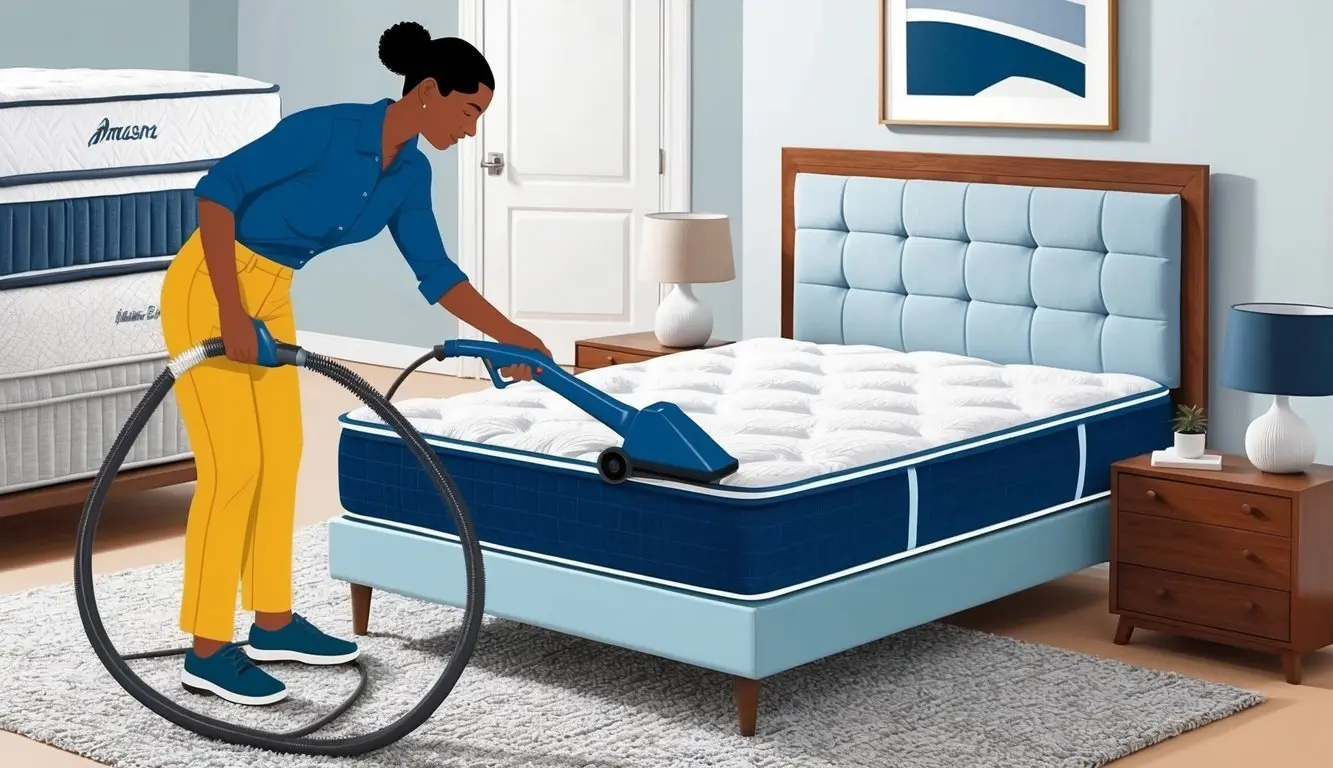Yes, a carpet cleaner can be used on a mattress, but it is important to follow a few safety steps to avoid damaging the fabric or leaving it too wet. Many people wonder if this is a safe and effective option for cleaning stains, dirt, or odors from their mattress.

This article covers what to know before using a carpet cleaner on a mattress, as well as tips to do it right. Readers will find out the pros and cons so they can decide if this method is suitable for their needs.
Can You Use a Carpet Cleaner on a Mattress?

A carpet cleaner can sometimes be used to clean a mattress, but results vary depending on the type of mattress and the material inside. Not all mattresses respond well to wet cleaning or the chemicals found in carpet cleaning solutions.
Differences Between Carpet and Mattress Materials
Carpet and mattress materials are not the same. Carpets are usually made from synthetic fiber, such as nylon or polyester, with a tough backing. Mattresses may have foam, cotton, latex, springs, or memory foam inside.
Carpet cleaners use water extraction and often strong cleaning solutions. These may be too harsh for some mattress materials, especially memory foam or latex, which can absorb moisture and chemicals. Excess moisture left inside a mattress can cause mold, mildew, or odors. Drying a mattress takes much longer than drying a carpet because mattresses are thicker.
A carpet cleaner’s brushes and suction are made for flat, dense surfaces. Mattresses are softer and more delicate than carpet, so too much scrubbing or suction could cause damage. For these reasons, it’s important to check cleaning instructions on the mattress tag before using a carpet cleaner.
Common Mattress Types and Carpet Cleaner Compatibility
Memory foam and latex mattresses: These absorb water easily. Using a carpet cleaner with too much water can harm their structure or cause mold. These should only be spot cleaned with minimal moisture.
Innerspring mattresses: These have coils with thin layers of padding. They’re less likely to absorb water quickly, but too much moisture may still reach the inside and cause rust or mildew. Carpet cleaners may be used carefully, but it’s best to use as little water as possible.
Hybrid mattresses: These combine foam and springs. The foam in these mattresses can still absorb water, so deep cleaning with a carpet cleaner is risky. Spot cleaning is safer.
Here’s a simple compatibility table:
| Mattress Type | Carpet Cleaner Safe? | Notes |
|---|---|---|
| Memory Foam | Not Recommended | High risk of soaking, damage, mold |
| Latex | Not Recommended | Can degrade and trap moisture |
| Innerspring | Use with Caution | Use little water, ensure drying |
| Hybrid | Risky | Spot clean only |
How to Clean a Mattress Using a Carpet Cleaner

Cleaning a mattress with a carpet cleaner can remove dirt, dust, and many stains. It works best when the right attachments and cleaning solutions are used for the fabric and the type of stain.
Choosing the Right Carpet Cleaner and Attachments
Not all carpet cleaners work well on mattresses. Choose a carpet cleaner with an upholstery attachment or a special wand because mattresses are more delicate than carpets.
The upholstery tool is usually smaller, with a gentle brush or suction head. This tool helps get into corners and seams. It also prevents the mattress from getting too wet, which helps it dry faster.
Check that the carpet cleaner’s suction is adjustable. Strong suction can damage some mattress fabrics. Most modern machines have settings for delicate surfaces. Always read the manual to confirm if the machine is safe for mattresses.
Step-by-Step Mattress Cleaning Process
- Vacuum the mattress to remove surface dust and debris before using the carpet cleaner.
- Attach the upholstery tool to the carpet cleaner.
- Lightly spray or apply the cleaning solution. Do not soak the mattress.
- Move the attachment slowly in straight lines.
- Use the suction to remove as much moisture as possible.
- Allow the mattress to dry completely before using it again.
Open windows, turn on fans, or use a dry towel to speed up drying. Make sure the mattress is fully dry to prevent mold or smells. If there are deep stains or odors, repeat the process or spot clean with an enzyme cleaner.
Recommended Cleaning Solutions
Use a cleaning solution made for upholstery or mattresses, not regular carpet shampoo. The best choices are those labeled as safe for fabrics and low-foam formulas.
For tough stains like urine or sweat, an enzyme cleaner breaks down odors and proteins. Look for enzyme solutions made for mattresses and bedding.
Avoid harsh chemicals or bleach, as these can ruin fabric or cause skin irritation. Always test a small hidden area first before cleaning the whole mattress. Read all instructions on the cleaner’s label to avoid problems.
Safe Cleaning Practices for Different Mattress Types

The steps for cleaning a mattress depend on the kind of mattress you have. Using the wrong method or tool may damage the mattress or reduce its lifespan, so it is important to follow safe practices for each material.
Cleaning a Memory Foam Mattress
Memory foam should not be soaked or saturated with water or cleaning solution. Too much moisture can cause mold or break down the foam’s structure. A carpet cleaner is usually not a good idea for memory foam because it uses too much liquid.
For safe memory foam cleaning:
- Use a handheld vacuum on the surface to remove dust or debris.
- Spot clean stains with a small amount of mild soap and water, using a sprayed cloth rather than spraying the mattress directly.
- Blot the area with a dry towel and let it air dry completely before putting sheets back on.
Never use harsh chemicals or heavy scrubbing on memory foam. Always limit moisture to avoid mildew. If deeper cleaning is needed, consider specialized upholstery cleaners made for memory foam.
Safely Cleaning a Spring Mattress
Spring mattresses are more durable and less likely to be damaged by a carpet cleaner. These mattresses have an inner coil support system and a fabric cover, so they can handle a little more moisture compared to memory foam.
Safe spring mattress cleaning steps:
- Vacuum the surface to get rid of dust and dirt.
- For stains, use the upholstery setting on a carpet cleaner with a mild solution. Do not oversaturate the mattress.
- Dry the cleaned area thoroughly with fans or leave it in a ventilated room to prevent mold.
Check the manufacturer’s label for care instructions. Avoid using hot water or strong chemicals, which may cause fabric damage or weaken stitching. Regular cleaning helps extend the life of a spring mattress and reduces allergens.
Natural and Chemical Cleaning Alternatives

Both natural and chemical cleaning options can be used for mattresses. Some methods focus on removing odors and stains with basic items from home, while others use machines or special cleaners.
Using Baking Soda for Mattress Cleaning
Baking soda is a common household product that helps with mattress cleaning. It is known for absorbing moisture and neutralizing odors, making it useful for people with allergies or sensitivities to chemicals.
Steps for using baking soda:
- Take off all sheets and bedding.
- Sprinkle a thin, even layer of baking soda over the whole mattress.
- Let it sit for at least 30 minutes. Letting it rest longer, such as a few hours, may work better.
- Use a vacuum cleaner to remove the baking soda.
Baking soda does not kill dust mites or remove all types of stains, but it works well for freshening up and mild odor removal. For tougher stains, an enzyme cleaner can be used after the baking soda treatment. Enzyme cleaners work on organic stains such as sweat, blood, or urine.
Steam Cleaning Considerations
Steam cleaning is another method used for mattresses. A steam cleaner uses hot steam to help kill dust mites, certain germs, and to loosen dirt on the mattress surface.
Before using a steam cleaner, check if the mattress can handle moisture and heat. Some mattresses, especially memory foam or those with delicate materials, may be damaged by steam.
When using a steam cleaner:
- Follow the manufacturer’s instructions.
- Use only water in the steamer. Do not add extra cleaning solutions unless the instructions say it is safe.
- Move the steam cleaner slowly, giving the steam time to clean.
- Allow the mattress to dry completely before sleeping on it. Moisture left inside the mattress can lead to mold or mildew.
Steam cleaning provides a deeper clean than baking soda alone. However, always be careful with how much moisture is used to protect the mattress.
Health Benefits of Mattress Cleaning

Regular mattress cleaning can help remove dust mites, allergens, and dirt particles. These steps support a cleaner sleeping space and may reduce allergy symptoms for some people.
Dust Mites and Allergen Removal
Dust mites are tiny bugs that live in mattresses and feed on dead skin. They are not visible to the naked eye, but they can cause allergies in many people. Common allergy symptoms include sneezing, coughing, watery eyes, and itchy skin.
Cleaning a mattress helps remove dust mites and the allergens they produce. Using a carpet cleaner with hot water extraction or a cleaning solution can help get rid of these particles. For added protection, some people choose to use a hypoallergenic mattress cover after cleaning.
Regular mattress cleaning not only controls dust mites, but it also removes other allergens like pollen, pet dander, and mold spores. This can make the air in the bedroom feel fresher and may help people sleep better at night.
Mattress Maintenance and Prevention Tips

Mattress maintenance is important for keeping a bed clean and safe. Using a mattress protector and following a simple cleaning routine help prevent stains, dust, and damage.
The Role of Mattress Protectors
A mattress protector acts as a barrier against spills, sweat, and dust mites. It keeps the mattress cleaner for longer and helps protect against stains that can be hard to remove.
Many mattress protectors are waterproof, making them useful for families with children or pets. They can also reduce exposure to allergens by blocking pollen and dust from reaching the mattress.
It’s helpful to choose a protector that fits tightly around the mattress, like a fitted sheet. Most protectors can be washed in a regular washing machine, which makes them easy to clean.
Benefits of Mattress Protectors:
| Benefit | Details |
|---|---|
| Stain Protection | Blocks spills and stains |
| Allergy Prevention | Reduces dust and allergens |
| Easier Cleaning | Machine washable |
| Extends Mattress Life | Prevents damage |
Establishing a Regular Maintenance Routine
Regular mattress maintenance helps prevent odors and keeps the bed feeling fresh. It is best to vacuum the mattress every month to remove dust and crumbs.
Spot clean stains as soon as they appear, using a small amount of gentle cleaner. Always let the mattress dry completely to avoid mold or mildew. Rotate or flip the mattress every three to six months to help it wear evenly.
Simple habits like washing bedding weekly and airing out the mattress improve cleanliness. By keeping up with maintenance, a mattress can stay comfortable and last longer.
Frequently Asked Questions

Using a carpet cleaner on a mattress depends on the type of mattress and the cleaner’s features. It is important to look at material safety, the right machine, and best drying practices.
Is it safe to use a carpet cleaner on a memory foam mattress?
It is usually not safe to use a carpet cleaner on a memory foam mattress. Memory foam can hold water, which may cause mold or damage the foam.
For spills and stains, spot cleaning with a small amount of water and gentle cleaner is safer.
What is the best carpet cleaner machine for cleaning a mattress?
A portable carpet cleaner with an upholstery attachment works well for most mattresses. Machines with a low-moisture setting are safest because they help prevent soaking the mattress.
Look for models with strong suction to help remove as much moisture as possible.
Are pillow top mattresses suitable for cleaning with a carpet cleaner?
Pillow top mattresses can be cleaned with a carpet cleaner if the tool uses little water. Too much moisture can stay trapped in the pillow top and cause mildew.
Test a small area first and allow for extra drying time.
How should you handle cleaning a sofa with a carpet cleaner in comparison to a mattress?
Sofas are often cleaned much like mattresses but may be easier because the material and padding are thinner. Use an upholstery attachment and avoid soaking the fabric.
Mattresses should not be overly wet and need longer drying times compared to most sofas.
How effective are carpet cleaners at removing urine stains from mattresses?
Carpet cleaners can remove urine stains from a mattress if the stain is fresh. Using an enzyme cleaner in the machine helps break down the stain and odor.
Old or deep stains may need extra treatments and more time.
What is the expected drying time for a mattress after cleaning with a carpet cleaner?
A mattress may take 8 to 24 hours to dry fully after cleaning with a carpet cleaner. Drying time depends on room temperature, air flow, and the amount of moisture used.
Placing the mattress in a well-ventilated area helps it dry faster.